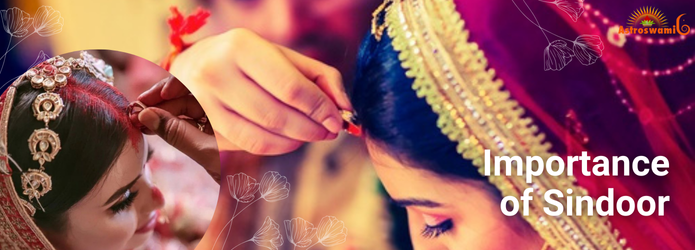
The tradition of Sindoor is considered to be very ancient in Indian culture, it is considered to be a great symbol of good fortune and Sindoor has a great cultural and religious significance for a woman, the word Sindoor is considered to be very sacred and also as a wedding ornament for Hindu women, it has been prevalent among women in Indian society for thousands of years, and it is associated with Vedas and Puranas.
If we talk about history, then the history of Sindoor seems to be very ancient. The use of Sindoor has also been seen in the Harappa and Mohenjo-Daro civilizations. During excavations, traces of Sindoor have been found in the parting of the idols of women. This evidence proves that Sindoor has been used in India for a very long time. It has been associated with ancient times. It is mentioned a lot in the Upanishads, Vedas, scriptures, Puranas, and unique stories of the Puranas. Many types of stories are associated with it, in which there is talk of Sindoor and the importance of Sindoor. So the history of Sindoor is linked to the roots of Indian society.
Sindoor is not just about beauty, but it has great spiritual importance. Sindoor is considered a sign of auspiciousness and love. Its red color is a symbol of fertility and also a sign of good fortune. Sindoor is filled in the parting of the same woman. Nowadays, married urban women are rarely seen with sindoor in their maang; otherwise, ancient Indian women, or those who belong to villages or towns, put a very long sindoor in their maang. It also works as a tilak, which starts from the tip of the nose and reaches the maang. It is a symbol of wishing for the husband's long life and prosperity, and it shows the energy and vibrancy in the life of women.
Cultural significance and influence of sindoor are also very high among people. In the Sanatani Hindu religion, marriage is considered complete only when the husband fills sindoor in his wife's maang. There are other rituals of marriage as well. But the ritual of sindoor bharai is very important. The Brahmin who conducts the marriage, after completing all the rituals and marriage ceremonies, fills sindoor in the parting of the newlywed bride three times with a gold ring by chanting the mantras of Maa Lakshmi, and they are officially declared husband and wife. This ritual is prevalent in different parts of Indian society in slightly different forms, but its basic meaning remains the same. Married women fill sindoor in their parting every day, which they see as dedication and respect towards their husband. Apart from this, sindoor is also used specially on special occasions and festivals. And for a woman, sindoor in the parting can be considered an important act of Pativrata Dharma.
Sindoor is not worn only for religious and cultural reasons, but according to other Hindu customs, there are scientific reasons for it too, and it is believed that the main components found in sindoor, such as turmeric and mercury and sindoor, are considered beneficial for health. Turmeric is a natural antiseptic, and while mercury controls blood pressure and also maintains mental balance, sindoor is important not only from a religious and spiritual point of view but also from a scientific point of view.
Sindoor is an integral part of our culture. It has great importance in our society and history. Our rituals and things are important in Indian culture and social fabric. We have inherited it from our ancestors, and we should preserve it. The use of sindoor is not just a tradition but also a symbol of good luck, love,e and power in the life of women. We all know this, and after Operation Sindoor, its importance increases even more, or we can say that Operation Sindoor has recognized its true importance.
1. What is Sindoor, and what is its religious significance?
→ Sindoor is a red coloured powder, which is used by women in Hindu culture in the parting of hair (middle of forehead). It is considered a symbol of good luck, long life for the husband, and marital bliss.
2. Why is Sindoor applied?
→ Religious reasons: Symbol of Goddess Parvati and her union with Lord Shiva. Tradition associated with Mata Sita and Goddess Lakshmi. Scientific reasons: Sindoor contains elements like turmeric, lime, and mercury, which help in controlling and keeping the mind calm.
3. Can widowed women apply Sindoor?
→ According to Hindu tradition, widows are not allowed to apply Sindoor, as it is a symbol of marital bliss. However, in modern times, some women may apply it as per personal choice.
4. Is Sindoor used only in the Hindu religion?
→ No, Sindoor is also used in Buddhism and Jainism. Some cultures also apply it as a part of worship and tika on auspicious occasions.
5. How to apply sindoor correctly?
→ It is applied in the middle of the forehead (maang) between the eyebrows. In some traditions, it is also applied over the bindi.

Free Astrology Consultation at our site, Astroswamig.com, we share the knowledge of Vedic Astrology that is an accumulation of years of astrological e...

When we talk about Zodiac signs, zodiacs to have their evil counterparts known as Black Zodiac....

Maa Skandamata - Navratri Day 5: Explore the significance, mantra, and detailed puja vidhi of Maa Skandamata on Navratri’s fifth day. Embrace her divi...

Tirupati Balaji Temple is one of the richest temples located in Andhra Pradesh....